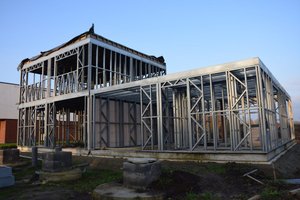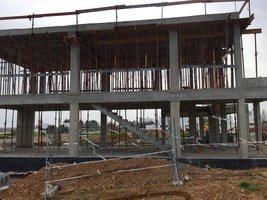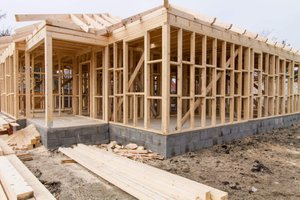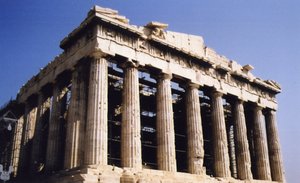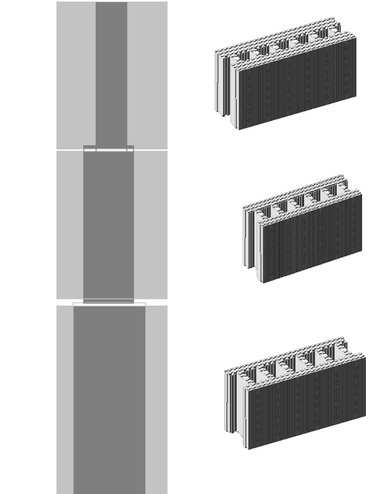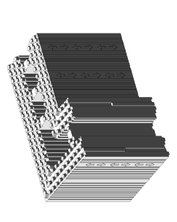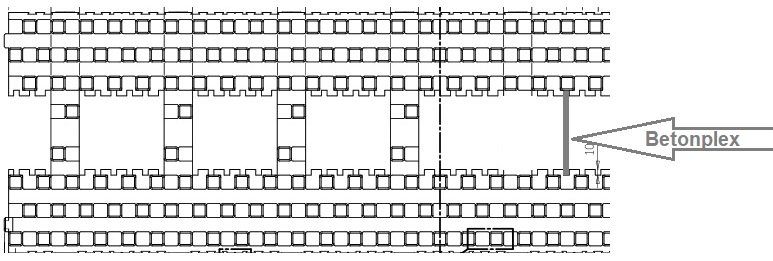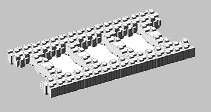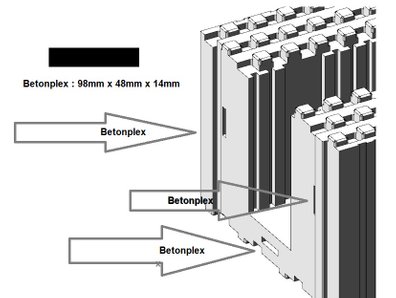EcoBriq® 42.50cm and 32.50cm
Reliable concrete construction systems
Type : 'Column construction
Saving of 25% on concrete consumption
Description of the column building system: EcoBriq®
A continuous wall construction with concrete columns of
EcoBriq® - 32,5cm : 15cm x 15cm thickness each
EcoBriq® - 42,5cm : 15cm x 15cm or 15cm x 20cm or 15cm x 25cm thickness each
The cavities in the building blocks serve as 'lost formwork' for making the concrete columns. They are each separated by a 5cm-thick strip of insulation.
This 5cm insulation keeps the inner and outer wall firmly together during the pouring of the concrete and serves afterwards as a kind of 'shock absorber' that absorbs possible foundation settlements and gives the building a certain flexibility in case of earthquakes.
The concrete columns are always anchored at the bottom in the foundation and connected at the top to the ring beam.
EcoBriq®
Concrete column construction
As with all other forms of window construction, the spaces that define the
structure of the building (wood, metal or concrete) are filled with insulation.
In the case of Ecobriq® , Neopor® spacers fulfil this function.
What is new and relevant about the Ecobriq® building system?
- The blocks are reversible in the 4 directions
- The metal or plastic webs have been replaced by Neopor® webs
This makes processing easier, e.g. shortening the blocks.
- The concrete columns have been centred
This makes it possible to stack the different building blocks on top of each other
Schematic representation - image 2
- The concrete column can be compacted with a vibrating needle
- The corner block can be used both as an inside and an outside corner
Figure 2
- The arrows on the block clearly indicate correct positioning
Figure 3
- Small dovetails for better adhesion
of decorative plaster, spray cork or plaster.
Figure 4
- Inside of the block - notches for inserting Betonplex (14 mm)
as a vertical sealing element
Figure 5
- The Neopor® webs serve immediately as a vertical sealing element
This is an immediate saving of 7€ per web!
- Preformed ribbons
No work on site to adapt the blocks with lintel elements
which in addition would cost 8€ each
Figure 6
- Perfect alignment of the ribbon elements
The ribbon sections can be joined together thanks to the notches on the sides where a Betonplex where a Betonplex sheet (9.8mm x 9.80mm x 0.5cm) can be inserted.
Figure 7
- Height control blocks of 5cm, 10cm and 30cm
Figure 8
Figure 1
Figure 2
Figure 3
Figure 5
Figure 4
Discard the web and install Betonplex as the sealing element.
It is easier to work with standard dimensions and cut the block according to the black line. Then you immediately have a stop for a window or door.
Figure 6
Figure 8
5cm 10cm 30cm
Figure 7
EcoBriq® - 42,50cm
Particularly suitable for high-rise buildings where a larger concrete core is required
Extremely popular with those who resolutely go for the best
the best insulated house possible
Concrete core 15 cm : Ueq [W/m²K] = 0,099 - Req [m²K/W] = 9,996
Concrete core 20cm : Ueq [W/m²K] = 0,1 17 - Req [m²K/W] = 8,361
Concrete core 25cm : Ueq [W/m²K] = 0,145 - Req [m²K/W] = 8,361
EcoBriq® - 32,50cm
Despite its limited wall thickness of 35.50cm
finished with e.g. stone strips and interior plaster
this block complies with the
standards of a passive house
15 cm : Ueq [W/m²K] = 0,145 - Req [m²K/W] = 8,361
By way of comparison: a timber frame with a wall thickness of 46.80cm only has an insulation value of U = 0.165W/M2K
+ Lower purchase price
+ Space gain of +/- 30%








































![EcoBriq Binnenpleister : 1cm Strongbau® : 42,50 cm Isolatie : 0 cm Spouwmuur : 0 cm Steenstrips : 2 cm Muurdikte 45,50 cm Ueq [W/m²K] = 0,099 Req [m²K/W] = 9,996 EcoBriq Binnenpleister : 1cm Strongbau® : 42,50 cm Isolatie : 0 cm Spouwmuur : 0 cm Steenstrips : 2 cm Muurdikte 45,50 cm Ueq [W/m²K] = 0,099 Req [m²K/W] = 9,996](/____impro/1/onewebmedia/Ecobriq/Column_type.jpg?etag=%22582b-627cc920%22&sourceContentType=image%2Fjpeg&ignoreAspectRatio&resize=191%2B334&extract=0%2B0%2B181%2B334&quality=85)
